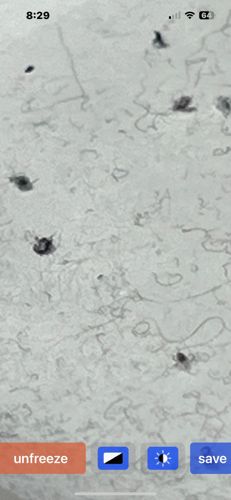Nematode (specifically, likely a plant-parasitic or free-living soil nematode based on the morphology observed, though exact species cannot be determined from the image resolution)
Scientific Name: As a phylum, there isn't a single scientific name for all nematodes. Examples of scientific names for specific species include Meloidogyne incognita (a root-knot nematode) or Caenorhabditis elegans (a free-living soil nematode). The organisms in the image are most likely belonging to this phylum.
Order & Family: Phylum Nematoda (often referred to simply as nematodes). Due to the lack of specific morphological details in the image, an exact order or family cannot be definitively identified.
Size: Most nematodes are microscopic, ranging from 0.3 mm to several millimeters in length. Some parasitic species can be much larger, reaching up to several meters (e.g., whale parasites). The individuals in the image appear to be microscopic.

Natural Habitat
Nematodes are ubiquitous and found in almost every habitat on Earth, including soil, freshwater, marine environments, and as parasites within plants and animals. The image appears to show them on a surface, possibly a microscope slide, but their natural habitat would be soil or water.
Diet & Feeding
Diet varies greatly depending on the species. Plant-parasitic nematodes feed on plant roots and other tissues using a stylet (a needle-like mouthpart). Free-living nematodes can be bacterivores (feeding on bacteria), fungivores (feeding on fungi), carnivores (feeding on other nematodes or small organisms), or omnivores.
Behavior Patterns
Nematodes move in a characteristic undulating or thrashing manner. Plant-parasitic nematodes often locate roots by sensing chemical gradients. Many species undergo several molts as they develop from juvenile to adult. Some can enter a dormant state (anhydrobiosis) to survive adverse conditions.
Risks & Benefits
Risks: Many species of nematodes are significant agricultural pests, causing billions of dollars in crop damage annually (e.g., root-knot nematodes). Some nematodes are parasites of humans and animals, causing diseases like elephantiasis, river blindness, and pinworm infections. Benefits: Free-living nematodes play crucial roles in nutrient cycling and soil health by preying on bacteria and fungi. Entomopathogenic nematodes (EPNs) are beneficial insects, used as biological control agents against insect pests. They are also important model organisms in biological research (e.g., Caenorhabditis elegans).
Identified on: 8/29/2025